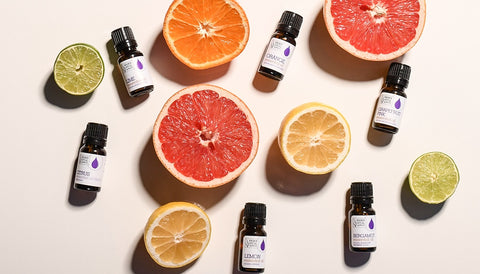Understanding Phototoxicity in Essential Oils

We’re officially mid-way through summer, but there’s still plenty of time to soak up the sun and spend time outdoors. While enjoying these sunny days, however, it’s crucial to be aware of how certain skincare products may interact with the sun. For instance, essential oils, beloved for their natural therapeutic properties, can sometimes pose hidden risks when exposed to sunlight.
This phenomenon is known as phototoxicity. It can lead to unexpected skin reactions, turning that sun-kissed glow into an uncomfortable experience. Not to worry though. At Source Vitál, we believe in empowering you with knowledge to enjoy your summer safely and beautifully. Here’s everything you need to know about phototoxicity and essential oils.

What is Phototoxicity?
Phototoxicity is a skin reaction that occurs when certain substances, including some essential oils, interact with ultraviolet (UV) light, like the sun. When applied to the skin and then exposed to sunlight, these oils can cause a range of reactions, from mild redness and irritation to severe burns and blistering. Common phototoxic essential oils include citrus oils like lemon, lime, and grapefruit. The compounds in these oils react under UV light, which may lead to skin damage.
Understanding phototoxicity is important for anyone using essential oils, especially during the sunnier months, as it helps prevent unwanted reactions and ensures a safe and enjoyable experience with these powerful natural products.
Phototoxic Essential Oils
Citrus oils are well-known for causing phototoxic reactions, but the situation is a bit more complex. Citrus oils that are cold-pressed or expressed generally contain higher levels of phototoxic compounds than those that are steam-distilled. For example, expressed citrus oils like Bergamot and Lime are highly phototoxic, while oils like Orange and Mandarin are relatively safer when used alone. Blending these oils, however, may increase the risk. Beyond citrus essential oils, there are several others that are known to be phototoxic, with some oils having uncertain phototoxic risks.
Known Phototoxic Essential Oils
-
Bergamot (citrus bergamia)
-
Blood Orange (citrus sinensis)
-
Lime (citrus aurantifolia)
-
Lemon (citrus limon)
-
Ginger Root (zingiber officinale roscoe)
-
Tagetes (tagetes minuta)
-
Angelica Root (angelica glauca)
-
Grapefruit (citrus paradisi)
-
Lovage (levisticum officinale)
-
Mandarin (citrus nobilis)
-
Tangerine (citrus reticulata)
-
Petitgrain Bigarade (citrus aurantium v. amara)
-
Neroli Absolute (citrus aurantium)
One Final Caution
Always check for phototoxic oils in undiluted essential oils from your favorite vendor. If phototoxic ingredients are present, treat the blend as phototoxic unless you are certain the oils have been diluted to a safe enough level.Although phototoxic reactions are relatively uncommon, it's best to be cautious and follow safety instructions.
At Source Vitál, we prioritize transparency regarding your health and safety. For detailed information about the origins, extraction methods, and biological makeup of our essential oils, please visit the 'Background and Details' section beneath each oil on our website.


Leave a comment